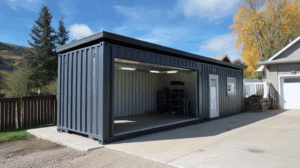Maximize Your Space: How a 20 ft Shipping Container Can Transform into a Garage
In today’s fast-paced world, space is a valuable commodity. Whether you live in a bustling city or a suburban neighborhood, finding room for all your belongings can be a challenge. If you’re in need of extra storage or a secure space to park your vehicle, look no further than a 20 ft shipping container. These versatile structures have gained popularity in recent years for their ability to be transformed into various functional spaces, including garages.
The Benefits of a Shipping Container Garage
-
Cost-effective: Building a traditional garage can be a costly endeavor, requiring permits, materials, and labor. On the other hand, a shipping container garage offers a more affordable alternative. You can purchase a used container at a fraction of the cost of building a garage from scratch.
-
Quick and easy setup: Unlike traditional construction, setting up a shipping container garage is a breeze. Once the container is delivered to your property, all you need is a level surface to place it on. With minimal modifications, such as adding windows, doors, and ventilation, your garage will be up and running in no time.
-
Durability and security: Shipping containers are built to withstand the rigors of international transport. Made from sturdy steel, they are resistant to harsh weather conditions and provide excellent security for your vehicle and other belongings. You can have peace of mind knowing that your garage is virtually impenetrable.
-
Portability: One of the most significant advantages of a shipping container garage is its portability. If you decide to move or rearrange your property, you can easily transport your garage to a new location. This flexibility allows you to adapt to changing needs without the hassle of building a new structure from scratch.
Transforming Your Shipping Container into a Garage
While shipping containers are a great starting point for a garage, a few modifications are necessary to make it functional and comfortable.
-
Insulation: Proper insulation is crucial for maintaining a comfortable temperature inside your garage. Insulating your shipping container helps to regulate heat, keeping it cool in the summer and warm in the winter. This can be achieved by adding insulation panels or spray foam insulation.
-
Electrical and lighting: To make your garage fully functional, you’ll need to install electrical outlets and lighting fixtures. This will allow you to use power tools, charge your vehicle, and illuminate the space adequately.
-
Ventilation: Good ventilation is essential for keeping the air inside your garage fresh and free from moisture. Installing vents or fans will help prevent the buildup of condensation and mold, keeping your vehicle and belongings in top condition.
-
Organization and storage solutions: Utilize the vertical space in your shipping container by installing shelves, hooks, and cabinets. This will help you keep your garage organized and maximize storage capacity. Consider adding a workbench or tool storage to create a functional workspace.
Conclusion
A shipping container garage is a cost-effective, durable, and versatile solution to maximize your space. With its quick setup, portability, and ability to be customized to your needs, it’s an excellent alternative to traditional garages. By making a few modifications, you can transform a 20 ft shipping container into a functional and secure space to protect your vehicle and store your belongings. Embrace the potential of your space and consider the possibilities a shipping container garage can offer.
From Storage to Shelter: The Benefits of a 20 ft Shipping Container Garage
Are you in need of extra space for your vehicles, tools, or hobby equipment? Look no further than a 20 ft shipping container garage. These versatile structures are not only cost-effective but also offer a wide range of benefits that make them an excellent choice for anyone looking to convert storage into a shelter. In this blog post, we will explore the advantages of a 20 ft shipping container garage and why it might be the perfect solution for your storage needs.
1. Durability and Security
One of the key benefits of using a shipping container as a garage is its durability. Built to withstand harsh weather conditions and the rigors of international shipping, these containers are made from high-quality steel that can withstand heavy loads and resist corrosion. Whether you live in an area prone to extreme temperatures, strong winds, or heavy rainfall, a shipping container garage will provide the ultimate protection for your vehicles and equipment.
Moreover, these containers are designed with security in mind. Equipped with robust locking mechanisms, they offer a safe and secure space for storing your valuable possessions. Say goodbye to worries about theft or vandalism – a shipping container garage provides peace of mind, allowing you to focus on other important matters.
2. Customizability and Flexibility
Another advantage of a 20 ft shipping container garage is its customizability. These containers can be easily modified to suit your specific needs. Whether you require additional windows, ventilation, insulation, or electrical wiring, the container can be easily adapted to accommodate these requirements. With a little creativity, you can transform a simple container into a fully functional workshop, studio, or even a living space.
Furthermore, the modular nature of shipping containers allows for easy expansion. If your storage needs grow over time, you can simply add more containers to increase the available space. This flexibility makes shipping container garages an excellent choice for both short-term and long-term storage solutions.
3. Cost-Effective Solution
Compared to traditional brick-and-mortar garages or storage facilities, a shipping container garage offers a cost-effective alternative. The initial purchase of a container is significantly more affordable than constructing a new building. Additionally, the maintenance costs of a shipping container garage are minimal, as they are designed to withstand years of use without requiring extensive repairs or renovations.
Furthermore, if your storage needs change or you decide to relocate, a shipping container garage can easily be transported to a new location. This eliminates the need for costly demolition or rebuilding, saving you both time and money.
4. Environmental Friendliness
In today’s world, where sustainability is a growing concern, using a shipping container as a garage is an environmentally friendly choice. By repurposing a used container, you are reducing waste and minimizing the demand for new construction materials. Additionally, shipping containers are designed to be reused and can serve multiple purposes throughout their lifespan, further reducing their environmental impact.
Furthermore, the durability of these containers means they have a long lifespan. Unlike wooden structures that may require frequent repairs or replacements, a shipping container garage will last for many years, reducing the need for constant construction and minimizing overall waste.
Conclusion
A 20 ft shipping container garage offers numerous benefits for anyone seeking extra storage space. From its durability and security to its customizability and cost-effectiveness, a shipping container garage provides a practical and versatile solution. Whether you need a garage for your vehicles, a workshop for your hobbies, or additional storage space, a shipping container garage can meet your needs while offering a unique and sustainable alternative to traditional structures. So why settle for standard storage when you can turn it into a shelter that perfectly suits your requirements?
Creative and Cost-Effective: Designing Your Dream Garage with a 20 ft Shipping Container
Are you tired of parking your car on the street or cluttering up your driveway with tools and equipment? If you’re in need of a garage space but don’t want to break the bank, consider thinking outside the box – or in this case, outside the shipping container.
Shipping containers have gained popularity in recent years as a versatile and affordable building material. While most people associate them with transporting goods across oceans, these containers can serve a multitude of purposes, including creating a unique and functional garage space.
The Advantages of Using a Shipping Container
Cost-Efficiency
One of the main benefits of using a shipping container for your garage is the cost. Compared to traditional construction methods, repurposing a 20 ft shipping container can save you a significant amount of money. The container itself serves as a sturdy structure, eliminating the need for extensive framing and foundation work.
Durability and Security
Shipping containers are built to withstand harsh conditions at sea, making them incredibly durable and secure. Constructed from high-quality steel, these containers can withstand extreme weather, pests, and even potential break-ins. By using a shipping container as your garage, you can have peace of mind knowing that your vehicle and belongings are protected.
Portability
Unlike traditional garages, shipping containers are portable. Whether you’re moving to a new location or simply want to reposition your garage on your property, a shipping container offers the flexibility that traditional structures lack. This portability also allows for easy expansion or modification in the future, should your needs change.
Quick Construction
Building a traditional garage can be a time-consuming process, requiring permits, contractors, and weeks (if not months) of construction. In contrast, repurposing a shipping container as a garage offers a much quicker turnaround time. With minimal modifications, you can have your dream garage up and running in no time.
Designing Your Dream Garage
Planning and Layout
Before diving into the construction process, it’s essential to plan and design your garage space. Consider the size and dimensions of your container and how it will fit on your property. Think about the number of vehicles you need to accommodate and any additional storage space you might require.
Insulation and Ventilation
Shipping containers are typically not insulated, so it’s crucial to address this aspect when designing your garage. Insulation will help regulate temperature and prevent condensation buildup. Additionally, proper ventilation is essential to maintain air quality and prevent the accumulation of fumes or odors.
Lighting and Electrical
To maximize functionality, ensure your garage is well-lit with adequate lighting fixtures. Consider both natural light sources, such as windows or skylights, and artificial lighting options. It’s also crucial to plan for electrical outlets and wiring to power tools, charging stations, and other electrical needs.
Flooring and Storage Solutions
When it comes to flooring, you have various options. You can choose to keep the container’s original flooring, which is typically made of marine-grade plywood, or opt for a more durable and aesthetically pleasing alternative like epoxy-coated concrete. Additionally, consider clever storage solutions such as shelving, hooks, or overhead racks to maximize space and keep your garage organized.
Exterior Design
While the interior design is important, don’t neglect the exterior of your garage. Consider adding windows, a pedestrian door, or even a roll-up garage door for easy access. You can also get creative with the container’s exterior by adding a fresh coat of paint, cladding, or other decorative elements to match your aesthetic preferences.
Conclusion
Designing your dream garage with a 20 ft shipping container offers a creative and cost-effective solution for those in need of extra storage space. With their affordability, durability, and portability, shipping containers provide a unique opportunity to create a functional and stylish garage that suits your needs. So, why settle for a conventional garage when you can think outside the box and repurpose a shipping container into the garage of your dreams?
Thinking Outside the Box: Unleashing the Potential of a 20 ft Shipping Container Garage
When it comes to creative solutions for extra storage or workspace, thinking outside the box can lead to innovative and cost-effective options. One such solution is converting a 20 ft shipping container into a garage. These modular structures offer endless possibilities, and their versatility can be maximized by using them as a garage.
Embracing the Advantages of a Shipping Container Garage
1. Affordability and Accessibility
One of the biggest advantages of using a shipping container as a garage is its affordability. Compared to traditional construction methods, converting a shipping container is a cost-effective option. Additionally, shipping containers are readily available and can be easily transported to your desired location.
2. Durability and Security
Shipping containers are built to withstand harsh conditions at sea, making them extremely durable. Constructed with weather-resistant steel, they are designed to withstand extreme temperatures, strong winds, and even hurricanes. This durability translates to increased security for your vehicles and belongings, providing peace of mind.
3. Customizability and Flexibility
The modular nature of shipping containers allows for endless customization possibilities. Whether you need a single-car garage or a larger space for multiple vehicles, shipping containers can be easily modified to suit your needs. You can add windows, doors, insulation, electrical wiring, and even plumbing, turning the container into a fully functional and comfortable workspace.
4. Portability and Future Expansion
One of the unique benefits of a shipping container garage is its portability. If you ever need to relocate, you can simply transport your garage to your new location. Additionally, if your needs change over time, you can easily expand your garage by adding more containers. This scalability makes shipping container garages a versatile long-term solution.
5. Sustainability and Eco-Friendliness
Repurposing a shipping container as a garage is a sustainable choice. By giving new life to an otherwise unused container, you are reducing waste and minimizing the need for new construction materials. Furthermore, shipping containers can be designed with eco-friendly features such as solar panels, rainwater collection systems, and green roofs, further reducing your ecological footprint.
Creative Uses for a Shipping Container Garage
Beyond its primary function as a vehicle storage space, a shipping container garage can serve a variety of purposes. Here are a few creative ideas to inspire you:
1. Workshop or Studio
With proper insulation and electrical wiring, a shipping container garage can become an ideal workshop or art studio. The secure and private environment allows you to pursue your hobbies and creative endeavors without disturbing the rest of your household.
2. Home Gym
Transform your shipping container garage into a personal fitness sanctuary. Equip it with exercise equipment, mirrors, and proper ventilation to create the perfect home gym. This dedicated space will motivate you to stay fit and healthy without the need for expensive gym memberships.
3. Home Office
As remote work becomes increasingly popular, having a dedicated home office space is essential. Convert your shipping container garage into a comfortable and productive workspace. Install large windows to let in natural light and create a separate entrance to maintain work-life balance.
4. Extra Living Space
If you need additional living space for guests or family members, a shipping container garage can be converted into a cozy living area. Add insulation, windows, and plumbing to transform it into a guesthouse or a tiny home. This creative solution can provide affordable accommodation without the need for extensive renovations.
5. Storage Solutions
Lastly, if you simply need more storage space, a shipping container garage can be the perfect solution. Whether it’s for seasonal items, tools, or recreational equipment, the secure and weatherproof container will keep your belongings safe and organized.
Conclusion
Thinking outside the box and repurposing a 20 ft shipping container as a garage opens up a world of possibilities. The affordability, durability, and customizability of shipping containers make them an excellent choice for creating versatile spaces. Whether you need a garage, workshop, home gym, office, living space, or additional storage, a shipping container can be transformed to meet your specific needs. Embrace the potential of a shipping container garage and unlock a world of creative possibilities.
The Ultimate Guide to Building a 20 ft Shipping Container Garage
If you’re in need of extra storage space or a workshop, building a garage out of a shipping container can be a cost-effective and practical solution. Shipping containers are durable, readily available, and can be easily modified to create a functional garage. In this ultimate guide, we will walk you through the step-by-step process of building your very own 20 ft shipping container garage.
Step 1: Planning and Preparation
Before you start building, it’s important to plan and prepare for your project. Consider the following factors:
Permits and Regulations
Check with your local building department to ensure you have the necessary permits and comply with any regulations for building a garage on your property. They will provide you with information on setbacks, height restrictions, and any other guidelines you need to follow.
Site Selection
Choose a suitable location for your shipping container garage. Ensure the ground is level and stable enough to support the weight of the container. Take into account the accessibility, proximity to utilities, and any potential obstructions.
Design and Layout
Decide on the layout and design of your garage. Consider factors such as the number of vehicles you need to accommodate, additional storage requirements, and any specific features you want to include, like windows or a side door.
Step 2: Sourcing and Preparing the Shipping Container
Once you have your plans in place, it’s time to source a shipping container. Look for a reputable supplier or consider purchasing a used container. Ensure the container is in good condition, free from any major damage, and has a solid floor.
Preparing the Container
Before you start any modifications, thoroughly clean and sanitize the container. Remove any debris, oil stains, or rust. Apply a primer and paint the exterior to protect it from the elements. You may also want to insulate the container for temperature control.
Step 3: Modifications and Customizations
Now comes the fun part – transforming the shipping container into a functional garage. Here are some modifications you might consider:
Cutting Openings
Carefully measure and mark the areas where you want to cut openings for doors and windows. Use a plasma cutter or a reciprocating saw to make the cuts. Reinforce the edges with steel framing to maintain structural integrity.
Installing Doors and Windows
Choose high-quality, weather-resistant doors and windows for your garage. Install them securely, ensuring a proper seal to prevent leaks and drafts. Consider adding a roll-up garage door for easy access.
Electrical and Plumbing
If you require electricity or plumbing in your garage, hire a professional to handle the installation. Ensure all wiring and plumbing is up to code and meets safety standards.
Insulation and Ventilation
Insulate the interior of the container to regulate temperature and reduce condensation. Consider using spray foam insulation for maximum efficiency. Install vents or fans to ensure proper air circulation.
Step 4: Foundation and Anchoring
To ensure stability and prevent shifting, you’ll need to create a solid foundation and anchor your shipping container garage. Options include:
Concrete Slab
Pour a concrete slab foundation that extends slightly beyond the dimensions of the container. This will provide a stable base for your garage.
Piers or Footings
Alternatively, you can use piers or footings to support the corners and midpoints of the container. This method is suitable for areas with poor soil conditions.
Anchoring
Secure the container to the foundation using anchor bolts or welded brackets. This will prevent it from shifting or being displaced during extreme weather conditions.
Step 5: Interior Finishing and Organization
Once the structure is in place, it’s time to finish the interior of your shipping container garage. Here are some ideas for organization and customization:
Wall Coverings
Consider installing plywood or drywall to cover the container walls. This will provide a clean and finished look, as well as a surface for hanging tools or shelving.
Flooring
Choose a durable flooring option that can withstand heavy use and potential spills. Epoxy or rubber flooring are popular choices for garage spaces.
Storage Solutions
Install shelves, cabinets, and pegboards to maximize storage capacity and keep your garage organized. Consider adding a workbench or tool storage system for added functionality.
Step 6: Safety and Security
Don’t forget about safety and security measures to protect your valuable assets:
Lighting
Ensure adequate lighting both inside and outside your garage. Install motion-sensor lights for added security.
Security System
Consider installing a security system with surveillance cameras and an alarm system to protect your garage and its contents.
Fire Safety
Place fire extinguishers strategically throughout the garage and ensure they are easily accessible.
Step 7: Enjoy Your New Shipping Container Garage
Congratulations! You have successfully built your very own 20 ft shipping container garage. Now it’s time to enjoy the extra space, whether it’s for storing vehicles, working on projects, or pursuing your hobbies. Remember to maintain and regularly inspect your garage to ensure its longevity and functionality.
Building a shipping container garage allows you to repurpose a readily available resource and create a unique and versatile space. With proper planning, preparation, and careful execution, you can enjoy the benefits of a functional garage at a fraction of the cost of traditional construction methods. Happy building!




